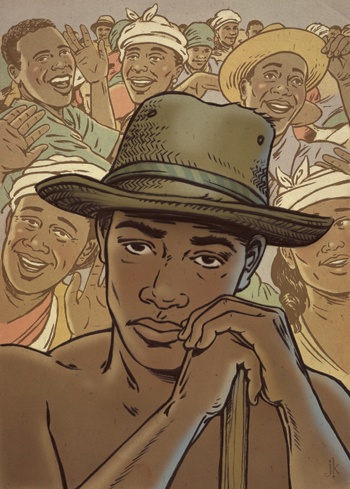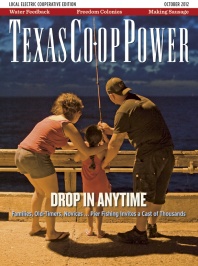Harrison Barrett was 15 years old and chopping weeds from a cotton patch in rural Harris County just north of Galveston on the San Jacinto River with several other slaves when word came that they were free. The other slaves commenced singing and dancing, but young Harrison didn’t join in. He said, “I don’t feel like dancing until I get Ma and my Pa and brothers and sisters, and then I’ll dance.”
Part of the singing and dancing came from the false notion that the freed slaves would get 40 acres and a mule from the federal government in compensation for their years and lives of bondage. What they got instead was the beginning of the Jim Crow culture of segregation in the South, including Texas, and what seemed for all the world like a new form of slavery—sharecropping. If the former slaves were going to get those acres and mules, they would have to buy them from whites, who were not always eager to sell good land or working animals to African-Americans. From this reality came the sharecropper, where any acres and any mules they worked belonged to somebody else.
The enduring image of the black sharecropper of the late 1800s is symbolized more than anything else by the shacks where they lived. Historian Loren Schweninger wrote, “The ‘cabin,’ built with rough-hewn lumber, was nearly always dark, dingy, and dilapidated, without windows, light or proper ventilation. It smelled of must, eating and sleeping, containing eight to ten people, it stood as a silent symbol of the degradation of landless blacks in the Deep South.”
But something else was happening. African-Americans did start buying their own land, settling their own communities and running their own affairs. The communities—which eventually included churches and schools—became known as freedmen’s settlements, usually called “freedom colonies” by the people who colonized them. History paid them scant attention until historians Thad Sitton and James H. Conrad wrote Freedom Colonies: Independent Black Texans in the Time of Jim Crow (University of Texas Press, 2005). While the image of the sharecropper has persisted in history and popular culture, the authors noted that land ownership among blacks actually skyrocketed during that time: 1.8 percent owned land in 1870, 26 percent in 1890 and 31 percent soon after 1900.
That land, however, was not prime real estate, as the authors note: “Most established themselves on pockets of wilderness, cheap land, or neglected land previously untouched by cotton agriculture.”
Many ex-slaves simply “squatted” on land, like Harrison Barrett. Soon after the war, Barrett began living on and working some land near the San Jacinto River with his blood family and an extended family of other former slaves. Barrett listed himself in the 1870 census as an “agriculture laborer,” but the land was pretty much his own to do with as he pleased, and he did so with the full knowledge and permission of his former owner, Reuben White, who finally sold him the land for 50 cents an acre in 1889. People of the community referred to him as “Uncle Harrison.” He helped build the first seven houses that gave the town of Barrett its start. He also established a sawmill, gristmill and coffee mill, and he donated land for the Shiloh Baptist Church, which also served as a school.
This is how many of the freedom colonies came to be—not by hook, crook or courthouse transaction, but by the fact that people began living every day in Barrett and in places like Peyton Colony in Blanco County, St. John Colony on the Caldwell-Bastrop county line, Hogjaw in Cherokee County and hundreds of others with names like Green Hill, Yellow Prairie, Red Branch, Weeping Mary, Board Bottom, Jerusalem, Freedman’s Ridge, Egypt, Frog, Elm and Slough.
These were isolated communities even in their own time, and records were kept mostly or entirely in the minds and hearts of one generation and then the next as the stories were told and told again, but rarely for the history books. Sitton and Conrad suggest that the image of the sharecropper’s shack was so powerful and so prevalent that historians missed or largely ignored the freedmen’s settlements. Black migrations out of the state were duly noted, but the people who stayed and made their own way were mostly ignored. “Historians largely missed the similar and more general response of the freedmen’s settlements, when ex-slaves remained in the South to establish all-black landowner communities as far away from white authority as possible,” they wrote.
The colonies fragmented, dwindled and in many cases were totally abandoned in the early decades of the 20th century. “Uncle Harrison” Barrett died in 1917, but the town named after him survives, where there is dancing in his honor, to be sure, every year during the annual Juneteenth celebration. In a sense, all of his family is there, just as he wished.
——————–
Clay Coppedge, frequent contributor. His book Texas Baseball: A Lone Star Diamond History from Town Teams to the Big Leagues (The History Press, 2012) was recently published.


